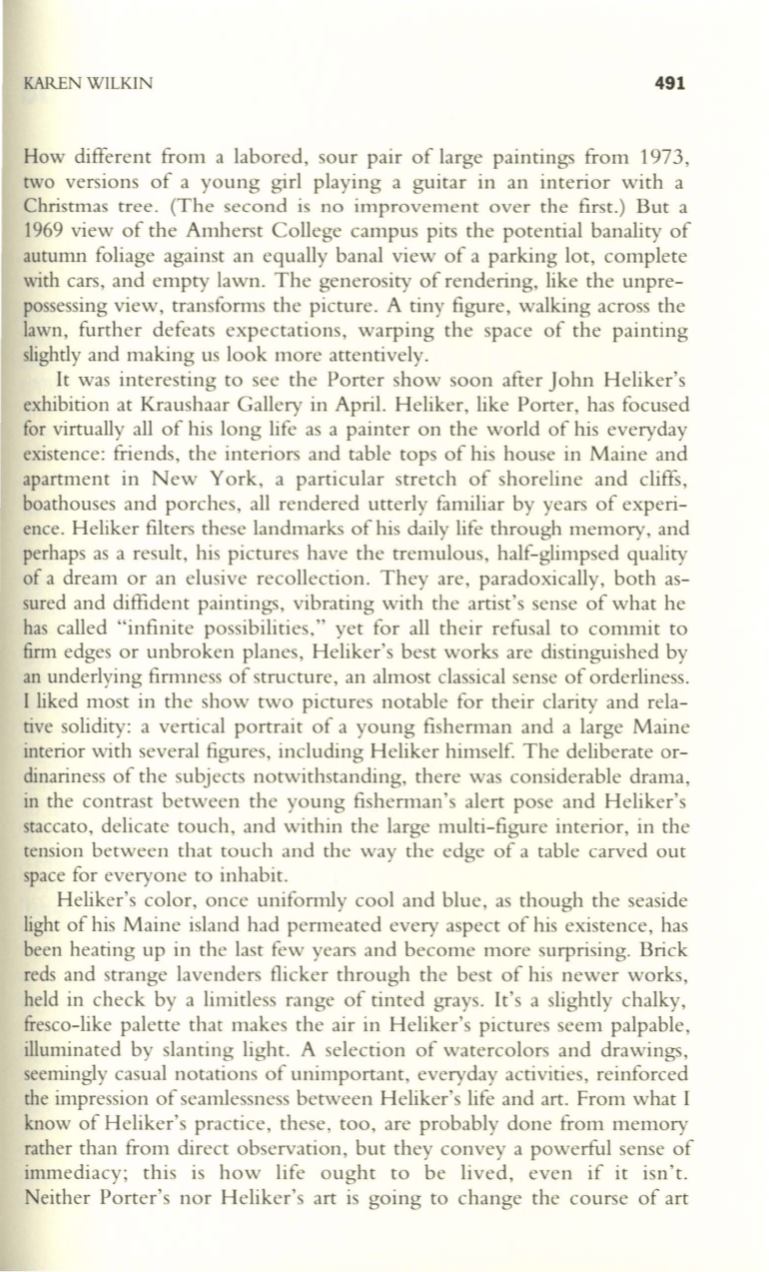
KAREN WILKIN
491
How different from a labored, sour pair of large paintings from 1973,
two versions of a young girl playing a guitar in an interior with a
Christmas tree. (The second is no improvement over the first.) But a
1969 view of the Amherst College campus pits the potential banality of
autumn foliage against an equally banal view of a parking lot, complete
with cars, and empty lawn. The generosity of rendering, like the unpre–
possessing view, transforms the picture. A tiny figure, walking across the
lawn, further defeats expectations, warping the space of the painting
slightly and making us look more attentively.
It was interesting to see the Porter show soon after John Heliker's
exhibition at Kraushaar Gallery in April. Heliker, like Porter, has focused
for virtually all of his long life as a painter on the world of his everyday
existence: friends, the interiors and table tops of his house in Maine and
apartment in New York, a particular stretch of shoreline and cliffs,
boathouses and porches, all rendered utterly familiar by years of experi–
ence. Heliker filters these landmarks of his daily life through memory, and
perhaps as a result, his pictures have the tremulous, half-glimpsed quality
of a dream or an elusive recollection. They are, paradoxically, both as–
sured and diffident paintings, vibrating with the artist's sense of what he
has called "infinite possibilities," yet for all their refusal to commit to
firm edges or unbroken planes, Heliker's best works are distinguished by
an underlying firmness of structure, an almost classical sense of orderliness.
I liked most in the show two pictures notable for their clarity and rela–
tive solidity: a vertical portrait of a young fisherman and a large Maine
interior with several figures, including Heliker himself. The deliberate or–
dinariness of the subjects notwithstanding, there was considerable drama,
in the contrast between the young fisherman's alert pose and Heliker's
staccato, delicate touch, and within the large multi-figure interior, in the
tension between that touch and the way the edge of a table carved out
space for everyone to inhabit.
Heliker's color, once uniformly cool and blue, as though the seaside
light of his Maine island had permeated every aspect of his existence, has
been heating up in the last few years and become more surprising. Brick
reds and strange lavenders flicker through the best of his newer works,
held in check by a limitless range of tinted grays. It's a slightly chalky,
fresco-like palette that makes the air in Heliker's pictures seem palpable,
illuminated by slanting light. A selection of watercolors and drawings,
seemingly casual notations of unimportant, everyday activities, reinforced
the impression of seamlessness between Heliker's life and art. From what I
know of Heliker's practice, these, too, are probably done from memory
rather than from direct observation, but they convey a powerful sense of
immediacy; this is how life ought to be lived, even if it isn't.
Neither Porter's nor Heliker's art is going to change the course of art


